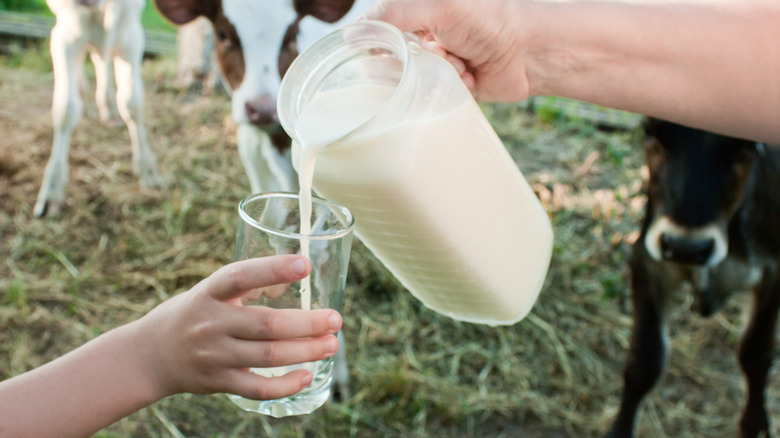Do Those Indents On The Sides Of Gallon Milk Jugs Actually Do Anything?
The milk jug as we know it today, made of hard clear plastic and usually weighing anywhere from a quart to a gallon, is relatively "new" in the world of dairy. As The Atlantic explains, milk was commonly sold and delivered in glass quarts — think of the image of the stereotypical milkman from the 1950s with a case full of milk bottles — as both refrigeration and insulating methods for milk products were still in their infancy.
As time went on, and technology in refrigeration improved, the switch from glass to the standard plastic jug began in the 1960s, via The New York Times. What seemed like a quaint marvel at that time has now become commonplace — while some places do serve milk in glass bottles, you're more likely to lug home a gallon of milk in an ice-cold plastic container than anything else.
On the side of the jug, you may notice a round circular indent, stamped on the other side of the handle. What exactly is that indent for?
The indent tells you if your milk is spoiled
If you ever opened a jug of milk, poured yourself a glass, and took a sip only to discover that the milk has gained a vile, sour taste, you probably wonder how you could have missed the expiration date. If only, you think, there was some way to know whether or not the milk was still good before you took off the cap.
According to The Dairy Alliance, that circular indent on the side of your jug is actually an indicator to tell if your milk has gone bad. While this circular indicator helps to reinforce the jug's shape, it also changes size depending on temperature. If the jug is sitting out at room temperature or is in a warm place, the indent may seem to get smaller as the plastic contracts in the humidity. A smaller indent on your jug of milk than when you purchased it may be a sign that the milk inside has gone bad.
A long-standing rumor similar to this was that, if the indent bulges outward, the milk inside the jug has gone bad. USA Today, however, tells us that such a claim is not true. Although the circular indent is good for telling if your milk is over or underfilled, and if it's been out in the heat or in the fridge, whether it expands in or out has no effect on seeing if the milk is still drinkable.
The indent also helps keep the jug from bursting
While this seems like an incredibly unlikely scenario, milk jugs can explode under the right conditions — and it's why that circular indent is there. As Mental Floss explains, milk contains microbes that naturally expel gas over time, which build up inside the jug-like air in a balloon. This "dimple," as they call it, reinforces the jug and allows it to expand to accommodate that extra pressure. As the milk begins to expire, these microbes release more gas and the pressure builds, which means that the indent must be flexible enough to allow the jug to expand until that pressure can be released (i.e. when the milk is dumped out).
Without this indent, the jug of milk wouldn't be able to handle the pressure as it builds up and thus explode. Keeping your milk cold rather than sitting out in the open helps to slow the spoilage, as the warm air outside the fridge can encourage the growth of bacteria and in turn build up more gas, via U.S. Dairy.


